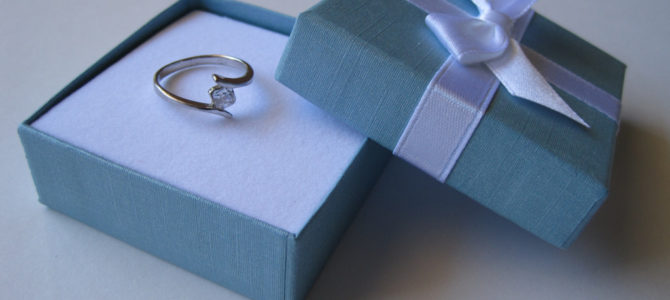
‘Tis the season for jewelers to increase their advertising. College football is being brought to us by jewelers telling us that what the women in our lives really want is something expensive that sparkles.
Of course, the merchants selling the stuff are not disinterested advisors. Jewelry stores exist to make money, not to promote good taste and prudent purchases. For example, some fashion criminal and marketing genius at Le Vian labeled their brown diamonds “Chocolate Diamonds,” and we have been bombarded with commercials promoting those ugly excrescences even since. My wife says if I ever get her one, she’ll know I no longer love her (not a worry, as the couple who watches sports and mocks jewelry commercials together stays together).
What the jewelry store wants to sell you is not necessarily what your lady wants. Thus, if you are contemplating a surprise jewelry gift, do some planning before wandering into a store. The woman you are buying for probably has a style of her own and, if she has taste, it’s not a vulgar “more is more” approach. Buying jewelry is not about getting the most bling for your buck, but about getting the right piece for the person who will wear it.
Learn Her Aesthetic Preferences
The first step is reconnaissance. Learn what types of jewelry she wears. For instance, if she always wears stud earrings, you should probably avoid buying big dangly hoops; if she always wears gold, you may want to avoid giving her something in silver. You could even talk to her about what she likes—there is a lot of space between giving her a complete surprise and having her pick what you are going to give her.
But while this sort of observation and discussion are helpful, they will only get you so far. At some point you will need to exercise judgment about what to buy, which means deciding what looks good. For many men, this is the hard part.
Unlike most of our purchases, aesthetics dominate jewelry decisions. Jewelry cannot be analyzed for functionality, because the appearance is the function—even the engineering marvels of a good mechanical watch have been functionally superseded by cheap digital timepieces and cellphones.
Nor can the value of jewelry be reduced to the cost of the materials. The purpose of jewelry design is not to layer on as much sparkle as a price point can take, any more than the goal of a song is to be as loud as possible with a given set of instruments.
Like other art, a piece of jewelry should have a coherent design; if it looks like the jeweler just slapped gems and metal together without anything much in mind, you should probably avoid it. However, this does not resolve the problem of distinguishing between good and bad designs. There is no avoiding this aesthetic problem, which is how to choose something tasteful within the constraints of her style and your budget.
Unfortunately, while good taste in jewelry can be developed (just as it can with art, food, wine, music and so on) it cannot be adequately conveyed in a set of propositions. You can find guides explaining how diamonds or pearls are graded, but there is no dispositive guide to good taste. Even money cannot buy good taste, although it can buy the services of those who possess it, provided the man with the money has enough sense to turn to them. Those of us without such wealth must rely on the guidance of acquaintances, salespeople, and our own best judgment.
Basic Guidelines For Taste
There is no definitive standard of taste in jewelry, but there are guidelines that can help. For instance, even if it is being advertised during a football game, do not buy your wife jewelry that reminds you of a Super Bowl championship ring, unless she reminds you of a linebacker. Avoid anything that looks like a tiny, bejeweled model of Soviet architecture, and remember that rows of gems are often less striking than a few well-placed jewels.
It also helps to set your budget and then evaluate on design and quality, rather than price. Online shopping often makes it easy to sort by price, or to look at a specific price range. In person, let the salesperson know your budget, then evaluate the options within it without focusing on cost. Looking only at what you can afford makes it easier to judge what looks best without worrying about comparing prices.
Good taste will also value design and quality over maximizing the amount of bling for your buck. Creating beautiful jewelry is not about adding more and more gemstones and precious metal, but about implementing a good design.
Consider Tiffany & Co., the iconic, oft-imitated, company. The prices Tiffany charges are due not only to the brand name, the excellent customer service, or even the quality. Rather, the cost is due to the designs, which tend to be elegant with a bit of whimsy. For example, their current olive leaf designs are distinctive, tasteful, fun and (since the proprietors are not idiots) available at a variety of price points, from the relatively affordable to the less so.


Of course, even an affordable design from Tiffany is still comparatively expensive, so their successful designs are often imitated by the big jewelry chains. These jeweled doppelgangers may or may not be as good, but for many they are close enough, and they are much cheaper. The lesson here is not that a store like Tiffany is overpriced, or that the big chains are full of inferior imitations. Either or both may be true. Buy what you can afford and think she will like, wherever you find it.

The lesson is that good jewelry is about tasteful design and quality production, not cost or total carats. There is a lot of ugly, expensive jewelry out there, but it can be ignored if you are not entranced by gaudy displays. If you are going to give her jewelry this year, ignore what the commercials tell you, and focus on what will match her style, your budget, and your best judgment of what is elegant, tasteful, and fun.









